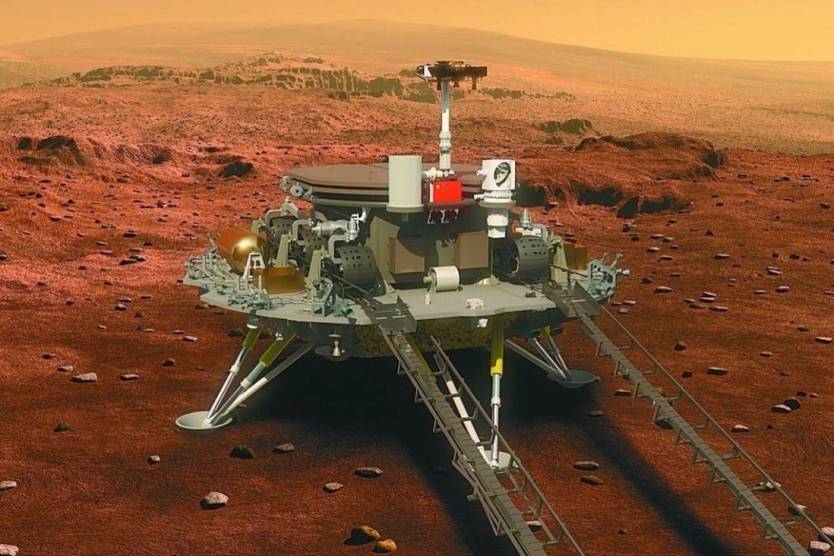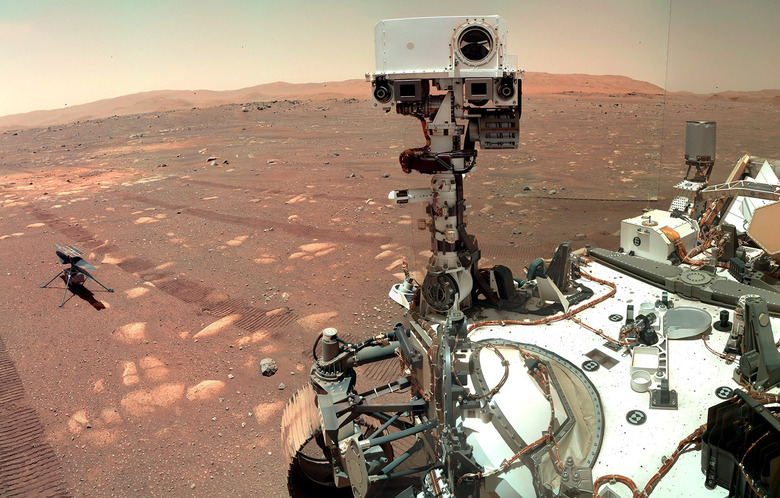China Just Landed A Rover On Mars
Perseverance and Curiosity have company on Mars, as of around 7:00 PM EST on Friday. China brought its lander down to the surface of the planet, which was carrying the Zhurong rover. China joins a select number of countries that have been able to orbit and successfully land a spacecraft on Mars, and it could become only the second after the US to operate a Mars rover. Zhurong isn't yet operational, as it hasn't rolled off the lander.
China's Tianwen-1 obiter reached Mars in February after a seven-month journey, orbiting the planet ever since and preparing for the daring landing. Unlike other Mars missions, China sent an orbiter to the planet that contained two critical payloads, the unnamed lander and the Zhurong rover. China will use the three devices to continue to gather data from Mars, further advancing the country's ambitious space exploration plans.
China landed on the far side of the moon in December, bringing back to Earth four pounds of rocks and soil. A few weeks ago, China successfully launched the core module of what will become its space station orbiting Earth, causing some panic as the rocket that brought the module to orbit re-entered the atmosphere in an uncontrolled freefall. Late on Friday, China reached another space milestone by landing on Mars.
China's state media did not report live on the landing but confirmed the achievement after the fact by dedicating hours of programming to the mission, The New York Times reports.
Congratulations to CNSA's #Tianwen1 team for the successful landing of China's first Mars exploration rover, #Zhurong! Together with the global science community, I look forward to the important contributions this mission will make to humanity's understanding of the Red Planet. pic.twitter.com/KexElIu8OH
— Thomas Zurbuchen (@Dr_ThomasZ) May 15, 2021
"Together with the global science community, I look forward to the important contributions this mission will make to humanity's understanding of the Red Planet," NASA's associate administrator for science Thomas Zurbuchen said while congratulating China on Twitter.
China's Mars landing is similar to the Perseverance mission, although there are some differences. Landers have to face the same issues upon entry into the atmosphere. At first, the lander has to withstand the excessive heat, which is done with the help of heat shields protecting the spacecraft. These are later ejected to make way for parachutes to reduce the speed as the lander drops through the thin Mars atmosphere.
The landing sequence lasts for "seven minutes of terror," which is what NASA engineers call it. It was nine minutes for Zhurong. The Tianwen-1 was orbiting the Red Planet, so its incoming speed wasn't as fast as Perseverance.

Concept art showing the Zhurong rover and lander.
The Tianwen-1 lowered its orbit at around 4:00 PM EST Friday, releasing the lander. According to a Chinese state-controlled Global Times report, the orbiter rose back to its parking orbit, and the lander spent three more hours circling Mars before entering its atmosphere.
The cone-shaped entry capsule carried the lander and rover, with a heat shield protecting the spacecraft from superheated gases during the initial part of the entry. Friction with the thin Martian "air" helped it slow down by about 90%. The heat shield was dumped at a lower altitude, and the parachute and the top piece were discarded. The lander then fired its rocket engine, looking for a safe spot to land in the Utopia Planitia.
The next steps of the mission will involve powering the 240kg (530 pounds) Zhurong rover and sending it to explore the great plain. The Chinese rover is about one-fourth the mass of Curiosity and Perseverence, but slightly heavier than the Spirit and Opportunity rovers that reached Mars in 2004.
Zhurong is meant to operate for 90 days, running on solar power like NASA's earlier rover models. Perseverance and Curiosity both make electricity from decaying radioactive plutonium. Zhurong has plenty of sensors, including cameras, radar that can penetrate the ground, a magnetic field detector, and weather stations. Like other rovers, China's machine will explore its surroundings and look for ice, a critical resources that Mars colonists will need.
The Utopia Planitia, part of Nowhere Land Plain, is a vast basin believed to have been created by a meteor impact. If Mars had water, this region would have been underwater.
